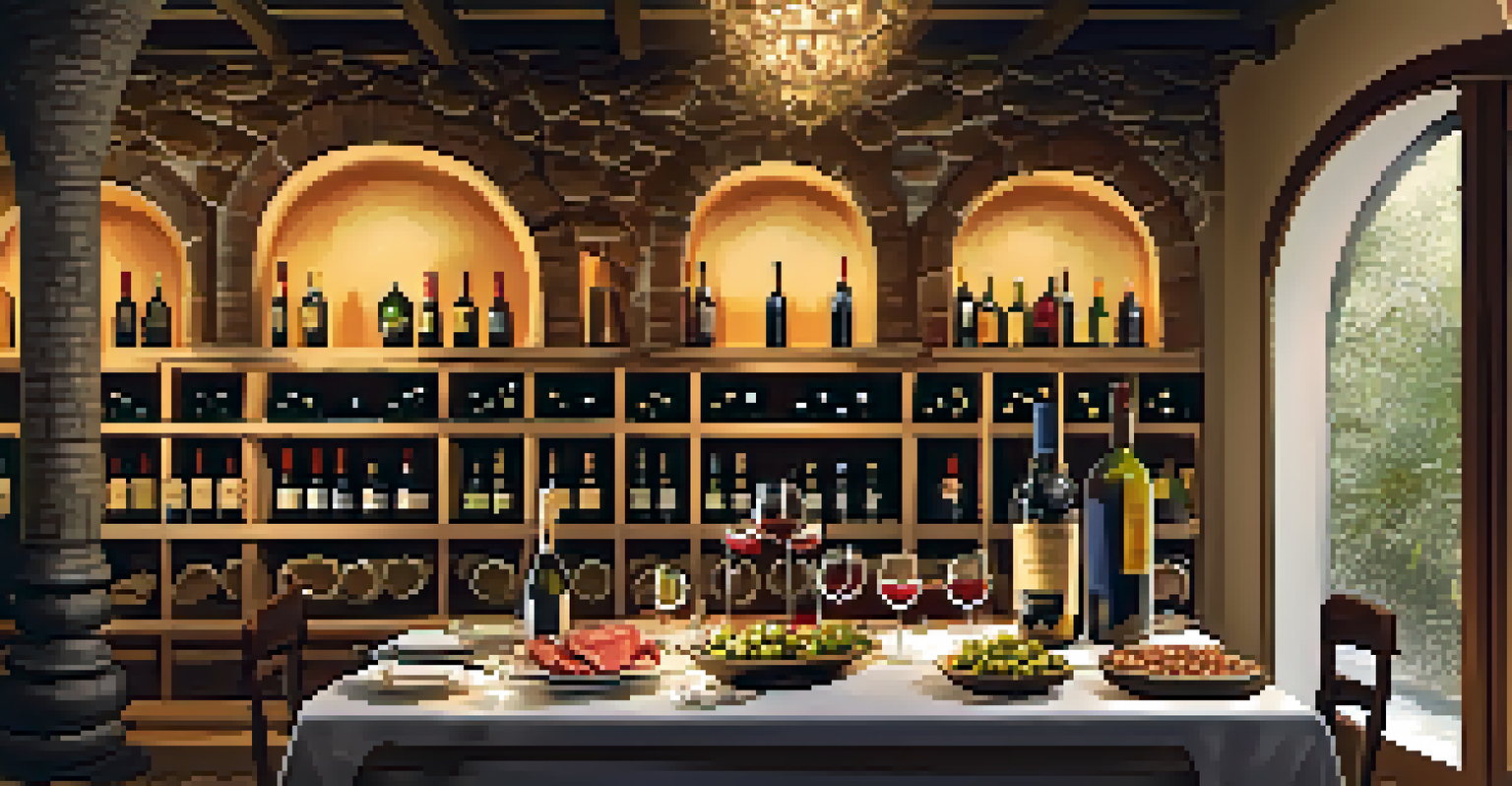Discovering the Vibrant Wine Regions of Spain: A Guide

An Overview of Spain's Wine Culture and History
Spain's wine culture is steeped in rich history, dating back thousands of years. From the ancient Romans to modern-day winemakers, each era has contributed to the vibrant landscape of Spanish wines. This deep-rooted tradition not only showcases the art of winemaking but also reflects the diverse geography and climate of the country.
Wine is sunlight, held together by water.
What sets Spain apart is its unique classification system, which includes Denominación de Origen (DO) regions. Each DO represents a specific area where certain grape varieties are cultivated, ensuring the quality and authenticity of the wines produced. This system helps consumers navigate the vast array of options available, making it easier to discover their favorites.
Visiting Spain's wine regions is like stepping into a living museum of viticulture. From the sun-drenched vineyards of Rioja to the terraced hillsides of Priorat, each location tells its own story through the wines it produces. Whether you're a wine novice or a connoisseur, exploring these regions offers a delightful journey through flavor and tradition.
The Iconic Rioja Region: A Wine Lover's Paradise
Rioja is perhaps the most famous wine region in Spain, celebrated for its exceptional red wines made primarily from the Tempranillo grape. With a landscape dotted with picturesque vineyards and charming bodegas, it's a must-visit for anyone passionate about wine. The region's commitment to quality and tradition makes it a benchmark for Spanish wines worldwide.

In Rioja, you can experience a range of wine styles, from young and fruity to aged and complex. The aging process is crucial here, with many wines labeled as Crianza, Reserva, or Gran Reserva, indicating the time they have spent in oak barrels and bottles. This classification helps wine enthusiasts select bottles that suit their taste preferences.
Spain's Wine Regions are Diverse
Spain's wine culture features a variety of regions like Rioja, Priorat, and Rías Baixas, each producing unique wines that reflect their local geography and traditions.
Beyond the wines, Rioja boasts stunning scenery and a rich culinary scene. Pairing your wine with local dishes like patatas a la riojana or chorizo a la sidra will enhance your experience, allowing you to savor the region's flavors in their entirety. A visit to Rioja promises a delightful blend of taste and culture.
Exploring the Unique Wines of Priorat
Priorat, known for its rugged terrain and steep slopes, produces some of Spain's most prestigious wines. This small region, located in Catalonia, is renowned for its powerful red wines crafted from Garnacha and Cariñena grapes. The unique llicorella soil, composed of slate, imparts a distinct minerality to the wines that is highly sought after.
In wine, there is truth.
The winemakers in Priorat are dedicated to sustainable practices, often employing traditional methods that emphasize quality over quantity. Many estates are small, family-run businesses that focus on producing limited quantities of exceptional wine. This artisanal approach adds to the allure of Priorat and makes each bottle a treasure.
Visiting Priorat offers not just a taste of its exceptional wines but also breathtaking views of the region's terraced vineyards. The combination of dramatic landscapes and rich flavors creates an unforgettable experience. Whether you're enjoying a glass at a local winery or exploring the charming villages, Priorat is sure to captivate your senses.
The Sparkling Wines of Cava: A Hidden Gem
Cava, the sparkling wine of Spain, is predominantly produced in the Penedès region, near Barcelona. Made primarily from indigenous grapes like Macabeo, Xarel·lo, and Parellada, Cava offers a delightful alternative to Champagne, often at a more accessible price point. This effervescent wine is perfect for celebrations or simply enjoying with friends.
The traditional method used to produce Cava involves a secondary fermentation in the bottle, similar to how Champagne is made. This technique creates the fine bubbles and complex flavors that Cava is known for. With a range of styles from dry to sweet, there's a Cava for every palate and occasion.
Cava and Sherry Offer Unique Flavors
Cava and Sherry showcase Spain's ability to produce distinctive sparkling and fortified wines, each with its own character and perfect for different occasions.
Exploring the Cava region is a treat for the senses, with vineyard tours and tastings available at numerous wineries. Pairing Cava with local tapas will enhance your experience, allowing you to appreciate the harmony of flavors. Whether you're toasting a special moment or enjoying a casual gathering, Cava brings a touch of celebration to any occasion.
Discovering the Wines of Rías Baixas: A Coastal Delight
Rías Baixas, located in the northwest of Spain, is celebrated for its white wines, particularly Albariño. The region's coastal climate and proximity to the Atlantic Ocean create ideal conditions for growing this aromatic grape, resulting in crisp, refreshing wines with vibrant acidity. Rías Baixas is a haven for seafood lovers, as its wines pair beautifully with local dishes.
Albariño wines are known for their bright flavors, often featuring notes of citrus, stone fruits, and floral aromas. These characteristics make them incredibly versatile, perfect for pairing with everything from fresh oysters to grilled fish. The region's emphasis on quality has led to a surge in popularity for its wines, both in Spain and internationally.
Visiting Rías Baixas allows you to explore charming seaside towns and picturesque vineyards. Take part in wine tastings at local wineries, where you can learn about the winemaking process and meet passionate vintners. The combination of stunning coastal views and exceptional wines makes Rías Baixas a must-visit destination for wine enthusiasts.
The Rich Wines of Jerez: Home of Sherry
Jerez, located in the southern part of Spain, is the birthplace of Sherry, a fortified wine with a unique character. Made primarily from the Palomino grape, Sherry comes in various styles, ranging from dry to sweet, each with its own distinct flavor profile. The region's warm climate and chalky soil play a crucial role in shaping the wines produced here.
One of the fascinating aspects of Sherry is its aging process, which involves a technique called 'solera.' This method blends wines of different ages, resulting in a consistent flavor and complexity. Whether you prefer the bone-dry Fino or the rich and nutty Pedro Ximénez, there's a Sherry to suit every taste.
Emerging Regions are Gaining Popularity
New wine regions such as Navarra and La Mancha are becoming increasingly recognized for their innovative techniques and diverse grape varieties, inviting wine enthusiasts to explore new flavors.
Exploring Jerez offers an immersive experience into the world of Sherry. Many bodegas offer tours and tastings, allowing you to learn about the production process and sample a variety of styles. Pairing Sherry with traditional tapas, such as jamón ibérico or olives, creates a delightful culinary experience that showcases the flavors of southern Spain.
The Emerging Wine Regions of Spain: New Frontiers
While traditional regions like Rioja and Jerez have long been celebrated, Spain's emerging wine regions are starting to steal the spotlight. Areas such as Navarra, Extremadura, and La Mancha are gaining recognition for their innovative winemaking practices and diverse grape varieties. These regions offer exciting opportunities for wine enthusiasts to discover new flavors and styles.
Navarra, known for its rosé wines, combines traditional techniques with modern approaches, resulting in refreshing and fruity offerings. Extremadura is making waves with its Tempranillo and Garnacha wines, showcasing the potential of this lesser-known area. Meanwhile, La Mancha is the largest wine region in Spain, producing a wide range of wines that cater to various tastes.

Exploring these emerging regions allows you to connect with passionate winemakers who are eager to share their stories. As these areas continue to grow and evolve, they promise to deliver unique and memorable wine experiences. Whether you're seeking adventure or simply looking to expand your palate, Spain's new wine frontiers are worth exploring.
Planning Your Wine Journey Through Spain
When planning a wine journey through Spain, timing and transportation are key factors to consider. The best time to visit is during the harvest season in late summer to early fall when vineyards are bustling with activity. This is an excellent opportunity to participate in grape picking and witness the winemaking process firsthand.
To navigate the various wine regions, renting a car is often the most convenient option. This allows you the freedom to explore at your pace and visit multiple bodegas in one day. Many regions also offer guided tours that include transportation, providing a hassle-free way to sample wines without worrying about driving.
Lastly, don't forget to immerse yourself in the local culture. Pairing your wine experience with regional cuisine enhances your journey, offering a taste of Spain's diverse culinary landscape. Engage with locals, participate in festivals, and savor every moment as you discover the vibrant wine regions of this beautiful country.